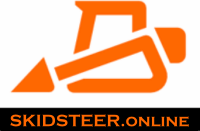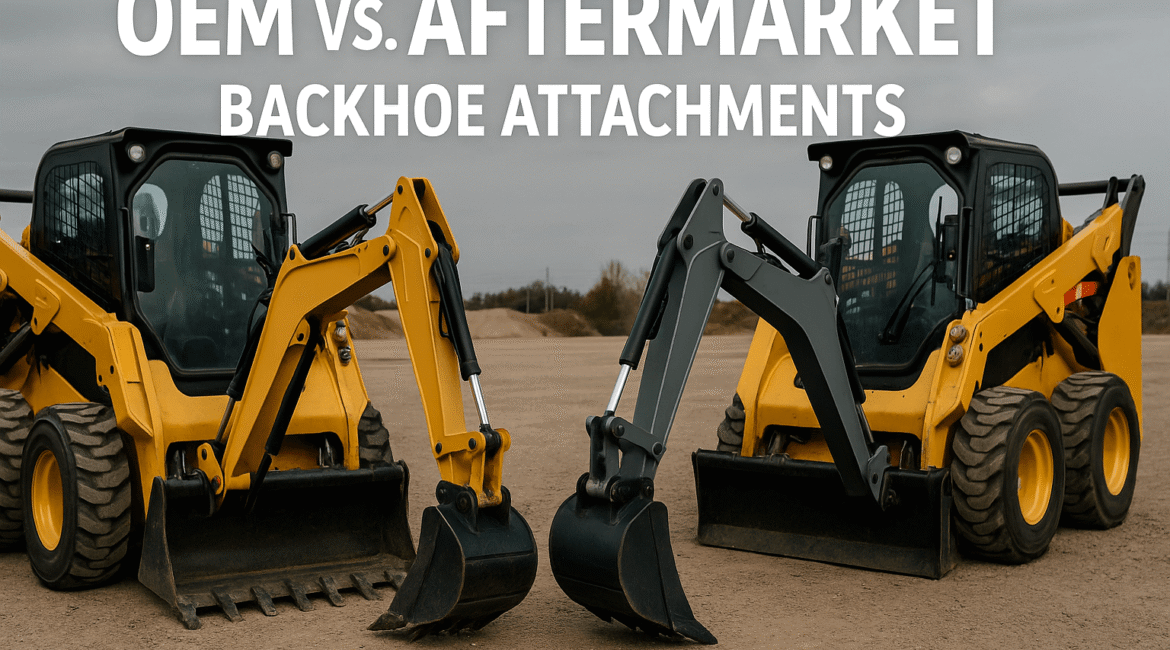OEM vs. Aftermarket Backhoe Attachments: Which One Delivers More Value?
Related Keywords: OEM attachments, aftermarket attachments, backhoe accessories, skid steer loader tools, heavy machinery attachments, cost of backhoe attachments, attachment durability, attachment compatibility
When dealing with heavy machinery such as backhoes and skid steer loaders, attachments are not only important but also play a very big role in maximizing productivity, versatility, and general operational efficiency. If you are digging trenches, breaking concrete, or moving debris, having a suitable backhoe attachment is very important for these tasks. However, when it is up to you to upgrade or replace the attachments, one question always arises: do you go for OEM (Original Equipment Manufacturer) or buy aftermarket attachments?
This guide will take you through the various scenarios of both, touching on performance, cost, compatibility, durability, and more. As a result, you will clearly be able to tell which type of attachment is a better investment for your wants on the side of the value question.
What Are OEM Attachments?
OEM attachments are leafh equipment or other parts that are designed and made by the very company that built your vehicle. For instance, in case the one brand of the backhoe you use is CAT, then the OEM attachment will be the one manufactured by Caterpillar of the same brand.
Learn the Advantages and Disadvantages of OEM Attachments:
OEM attachments are made by the same company that produces your equipment. There are variety of excavator brands in the USA which produce OEM attachments.
Advantages of OEM Attachments
Perfect Fit & Finish: Developed exclusively for the make and model of your machine, it means that everything will be assembled in the most precise manner.
High-Quality Materials: These are usually of high quality since they are under rigorous quality control.
Warranty Assurance: With such products, the warranty often gives extended protection.
Reliable Performance: The original equipment manufacturers engineer and specify the designs and the performance of the product according to the machine used.
Disadvantages of OEM Attachments
Higher Costs: Greater quality is associated with higher price.
Limited Variety: The range of supplies covered by the manufacturer might not include specialized or non-typical products.
Slower Lead Times: In the case of specific orders, there is a greater possibility that the shipping and production will consume more time than usual.
What Are Aftermarket Attachments?
Others manufacture and design the attachments of whatever kind. There are companies that conceptualize and make these attachments for various machines of different brands and models.
Learn the Advantages and Disadvantages of Aftermarket Attachments
Advantages of Aftermarket Attachments
Lower Cost: The price is much lower than the fee for OEM, which is quite appealing to buyers who take care of their budget.
Broader Selection: A majority of aftermarket brands offer a wider range of products, focusing on a particular area or designing unique attachments.
Faster Availability: The production in large quantities usually guarantees that items are still in stock and can be given as soon as you need them.
Disadvantages of Aftermarket Attachments
Variable Quality: The quality set by the different manufacturers is not the same.
Potential Compatibility Issues: There is no guarantee that all kinds of attachments will be easily installable or that they will be as reliable while performing the task.
Limited Warranty Support: Warranty conditions convey that warranty coverage is either less in duration or restrictive.
Key Comparison: OEM vs. Aftermarket Backhoe Attachments
Performance & Compatibility
OEM: The objects are designed in sync with the machine’s hydraulic and mechanical specifications. They are therefore best suited to the conduction of accurate tasks.
Aftermarket: Any adjustments or modifications are possible. Based on the brand, the source says that the performance may differ from each other.
The choice: OEM (provided that compatibility and accuracy are the most significant requirement)
Cost & Value
OEM: It may seem expensive from the beginning, but the level of reliability is extremely high here.
Aftermarket: Lower initial cost, which in turn can be useful in getting money for business operation.
Winner: Aftermarket (if you are looking for the most efficient option for you)
Durability & Build Quality
OEM: Regular production using the right materials and testing controls to ensure quality is maintained at all times.
Aftermarket: The quality of the products can vary hugely. In particular, those of high-end brands are extremely durable and offer better longevity, while those of low-cost brands may wear out much more quickly.
Winner: Tie (Depends on the brand and material)
Warranty & Support
OEM: Typically involves almost all guarantees and epic capacity in supporting the clients for a longer period of time.
Aftermarket: It is probable that they offer just basic warranties and fewer services.
Winner: OEM
Customization & Innovation
OEM: There is less flexibility to deal with special requests.
Aftermarket: There are many firms trying to create the best tools through innovation, which will lead them to have unique ones that were not offered by the ‘big boys.’
Winner: Aftermarket
Use Case Scenarios: Which One Is Better for You? – OEM vs. Aftermarket Backhoe Attachments
Scenario 1: Municipal or Government ContractsAftermarket attachments are a perfect fit for businesses with limited budgets as they deliver substantial savings in the cost of operations without significant changes in the level of performance.
Scenario 2: Custom Jobs or Niche Tasks
Suppose what you are doing at work is more particular like with forestry mulching or trenchless boring, then probably the aftermarket manufacturers have what you need.
Top-Rated Aftermarket Brands to Consider
- Titan Attachments
- Blue Diamond
- CID Attachments
- Land Pride
- Eterra
- Typhon
These brands are leading in the industry mostly due to the fact that they are the ones who, traditionally, keep both a necessary quality standard and a reduced price of production.
Cost Analysis: OEM vs. Aftermarket Backhoe Attachments
| Attachment Type | OEM Price Range | Aftermarket Price Range |
|---|---|---|
| Standard Bucket | $1,200 – $2,500 | $800 – $1,600 |
| Hydraulic Breaker | $8,000 – $12,000 | $4,500 – $8,000 |
| Auger Drive Unit | $3,000 – $6,000 | $1,800 – $4,000 |
| Grapple Bucket | $2,500 – $4,500 | $1,500 – $3,000 |
The prices are approximate figures for the U.S. in 2025 and such figures could differ depending on the region and the supplier.
Maintenance Considerations
Aftermarket: May need wider knowledge for the maintenance of the attachment; the search for the replacement part may also be difficult.
OEM: The original manufacturer; applying only their original parts and having service done by the technicians that were trained by the manufacturer.
Tip: Always check the compatibility of pins, hydraulics, and mounts before buying aftermarket parts.
Expert Recommendations
Stay with OEM for:
- Projects with a lot at stake
- Machines that are brand new
- Strategies for long-term investing
Stay with Aftermarket for:
If you want to buy aftermarket parts,
- You’re adding to a fleet of cars from different brands.
- Need replacements right away
- Cost savings are more important than optimum performance.
Some attachments have to comply with EPA, OSHA, or local emissions regulations. Original spare parts usually meet these standards, while it is a time-consuming process to confirm that the aftermarket equipment is compliant.
Final Verdict: Which One Delivers More Value?
The decision of whether to use OEM or aftermarket backhoe attachments is mainly based on your priorities—accuracy vs. cost, durability
| Category | Best Choice |
|---|---|
| Overall Quality | OEM |
| Price Efficiency | Aftermarket |
| Variety & Innovation | Aftermarket |
| Support & Warranty | OEM |
| Best Value Overall | Aftermarket (for most small to mid-sized contractors) |
Aftermarket backhoe attachments are the preferred choice for most small to mid-sized contractors as they deliver better value for money. However, for critical tasks where time is of the essence, sticking to the original OEM brand is the best choice.
FAQs
Are aftermarket backhoe attachments as durable as OEM ones?
A few aftermarket attachments are as good as, if not better than, OEM, but the quality factor highly depends on the manufacturer. Brands like
Will aftermarket attachments void my backhoe’s warranty?
Using non-OEM parts might void certain sections of your warranty. Before installation, make sure to reach out to the company of the equipment for this information.
How can I ensure an aftermarket attachment fits my backhoe?
Go through the compatibility charts, find the mount type and hydraulic flow spec, and first of all, contact customer support. Most brands produce matching information.
Is it safe to buy used aftermarket attachments?
Of course, but before that, the attachments must be checked for wear, rust, cracks, and hydraulic integrity. For repurchases, consider certified resellers.
Conclusion
Original Equipment Manufacturer (OEM) and aftermarket backhoe attachments each have their pros. Which one you prefer should rely on the needs of your business, your budget, and the complexity of the task. When chosen properly, aftermarket items can offer great value without sacrificing performance.
For the best attachments, go to our marketplace at SkidSteerLoader.net. We are a link that brings the professionals and the tough, time-proven equipment that stands through tough challenges on real jobsites.
If you want me to prepare metadata for uploading the blog, yes, just let me know. I shall do it immediately.

